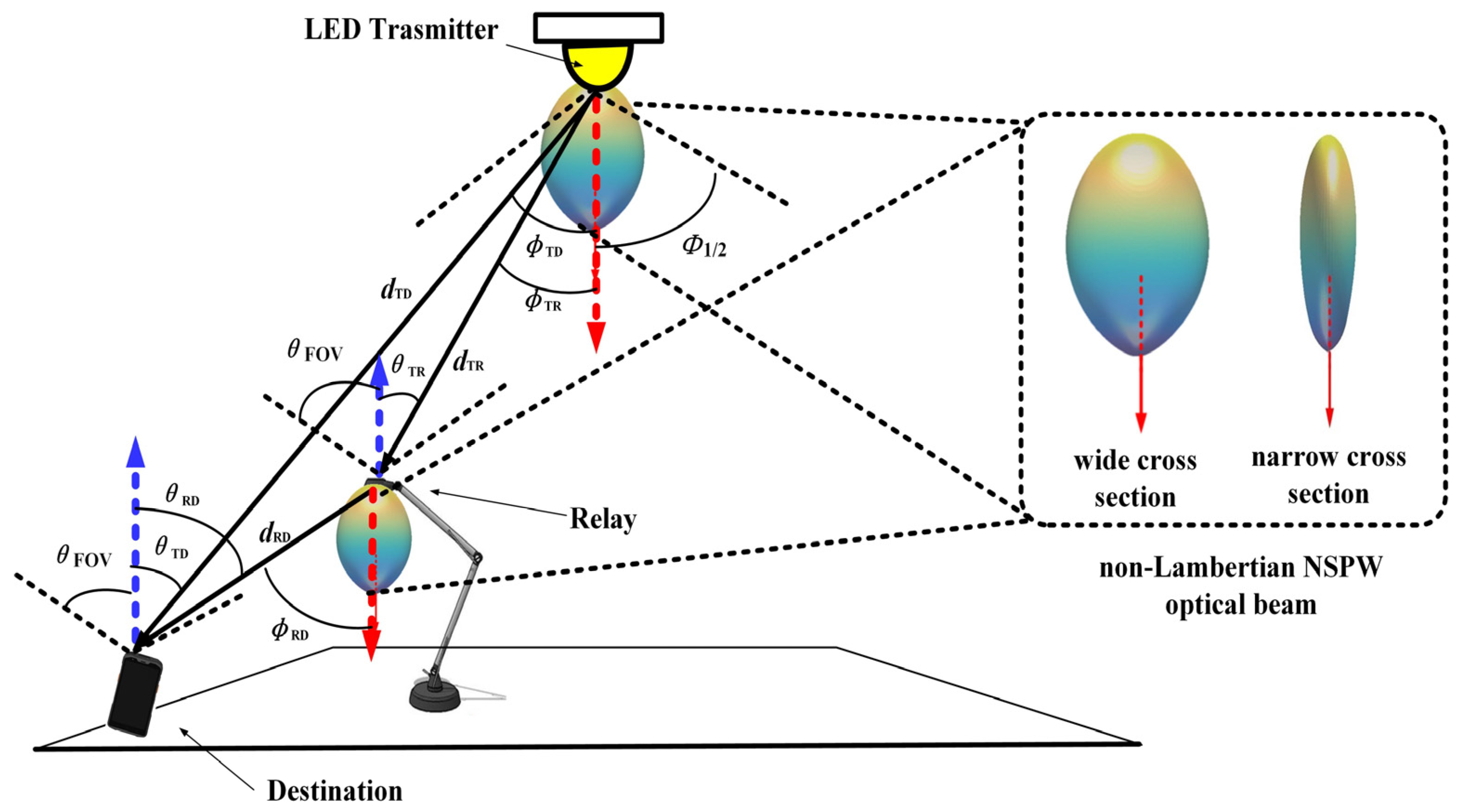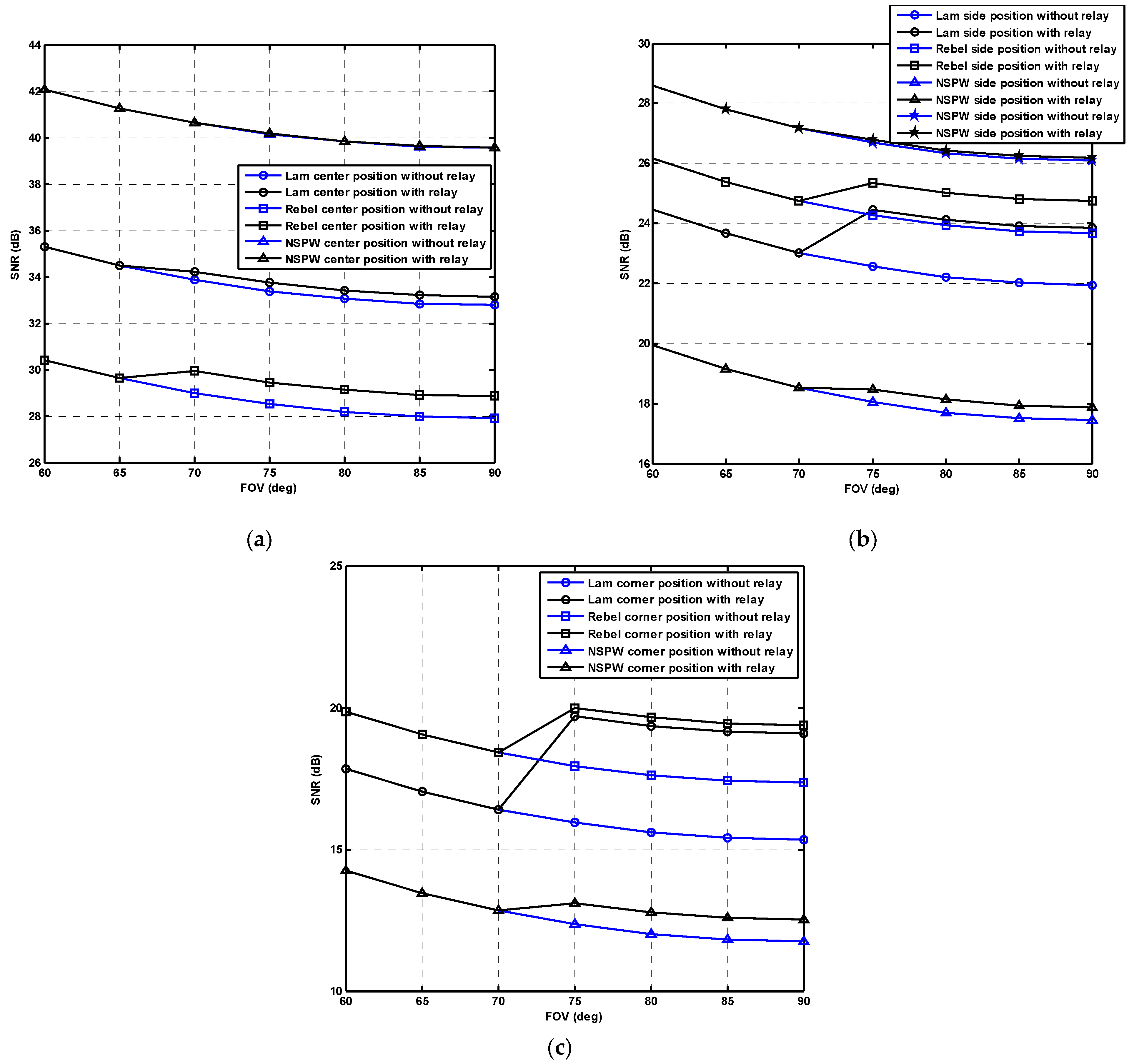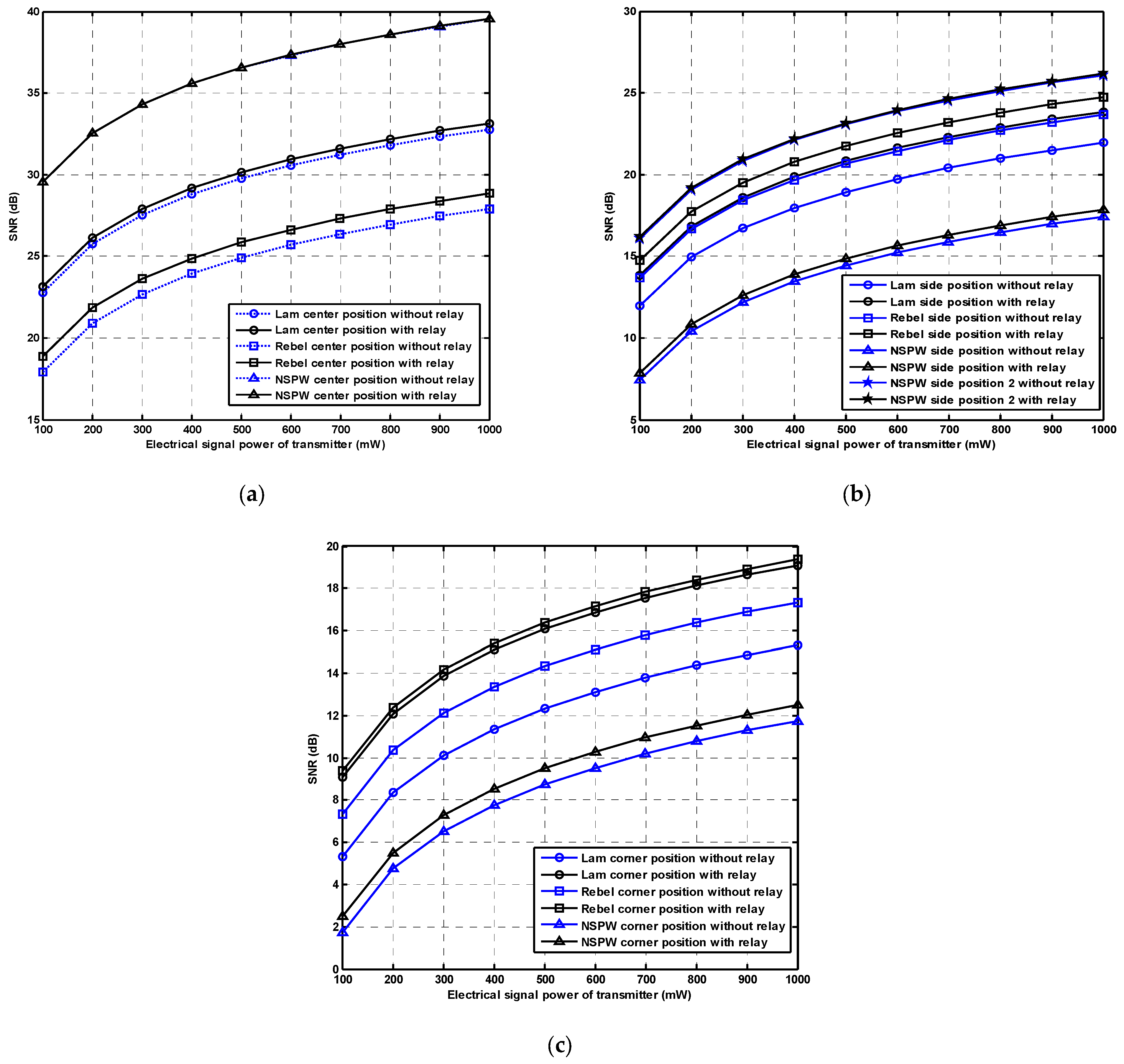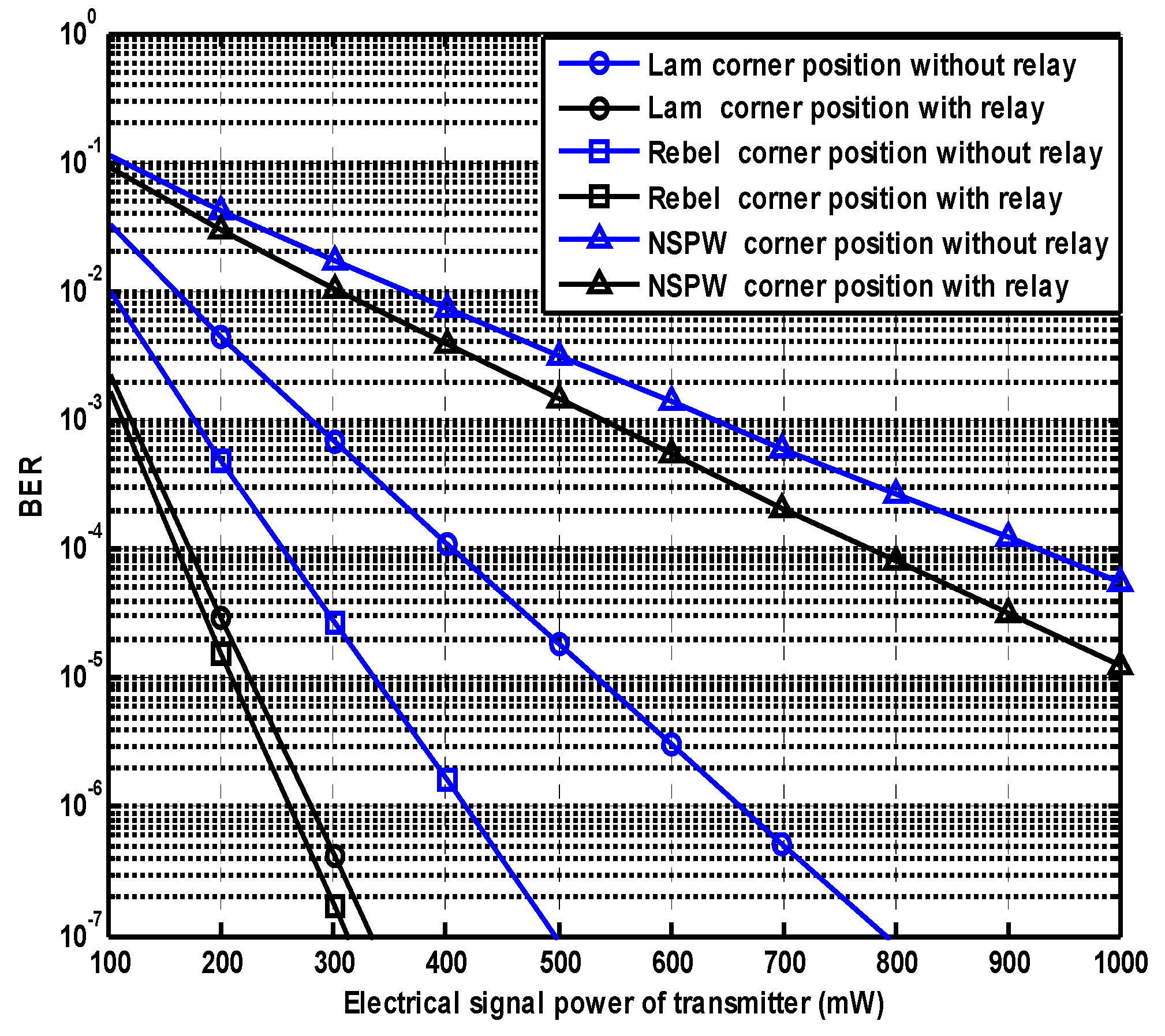On the Performance of Non-Lambertian Relay-Assisted 6G Visible Light Communication Applications
Abstract
1. Introduction
2. Relay-Assisted VLC Employing Diverse Optical Beam Configurations
2.1. Relay-Assisted VLC Employing Benchmark Lambertian Beam Configurations
2.2. Relay-Assisted VLC Employing Typical Rebel Non-Lambertian Beam Configurations
2.3. Relay-Assisted VLC Employing Typical NSPW Non-Lambertian Beam Configurations
3. Numerical Evaluation
3.1. Effect of FOV
3.2. Effect of Aperture Size
3.3. Effect of Emitted Signal Power
4. Conclusions
Author Contributions
Funding
Institutional Review Board Statement
Informed Consent Statement
Data Availability Statement
Conflicts of Interest
References
- Zhang, Y.; Zhang, H.; Cosmas, J.; Jawad, N.; Ali, K.; Meunier, B.; Kapovits, A.; Huang, L.K.; Li, W.; Shi, L.; et al. Internet of radio and light: 5G building network radio and edge architecture. Intell. Converg. Netw. 2020, 1, 37–57. [Google Scholar] [CrossRef]
- Chowdhury, M.Z.; Hossan, M.T.; Islam, A.; Jang, Y.M. A comparative survey of optical wireless technologies: Architectures and applications. IEEE Access 2018, 6, 9819–9840. [Google Scholar] [CrossRef]
- Sun, S.; Yang, F.; Song, J. Sum rate maximization for intelligent reflecting surface-aided visible light communications. IEEE Commun. Lett. 2021, 25, 3619–3623. [Google Scholar] [CrossRef]
- Sun, S.; Wang, T.; Yang, F.; Song, J.; Han, Z. Intelligent reflecting surface-aided visible light communications: Potentials and challenges. IEEE Veh. Technol. Mag. 2022, 17, 47–56. [Google Scholar] [CrossRef]
- Wang, T.; Yang, F.; Song, J.; Han, Z. Dimming Techniques of Visible Light Communications for Human-Centric Illumination Networks: State-of-the-Art, Challenges, and Trends. IEEE Wirel. Commun. 2020, 27, 88–95. [Google Scholar] [CrossRef]
- Eltokhey, M.W.; Alouini, M.-S. Searchlight-Assisted Feeder Links for UAV-Based VLC Networks. IEEE Commun. Mag. 2025, 63, 158–164. [Google Scholar] [CrossRef]
- Hamza, A.S.; Deogun, J.S.; Alexander, D.R. Classification framework for free space optical communication links and systems. IEEE Commun. Surv. Tuts. 2019, 21, 1346–1382. [Google Scholar] [CrossRef]
- Kizilirmak, R.C.; Narmanlioglu, O.; Uysal, M. Relay-Assisted OFDM-Based Visible Light Communications. IEEE Trans. Commun. 2015, 63, 3765–3778. [Google Scholar] [CrossRef]
- Oliveira, M.; Monteiro, P.; Pohl, A. Performance Improvement of VLC Systems Employing an Amplify-and-Forward Scheme. In Proceedings of the 2019 22nd International Symposium on Wireless Personal Multimedia Communications (WPMC), Lisbon, Portugal, 24–27 November 2019; IEEE: New York, NY, USA, 2019. [Google Scholar]
- Zhu, M.; Wang, Y.; Liu, X.; Ma, S.; Zhang, X.; Fu, Y. Performance Analysis for DF Relay-aided Visible Light Communication System with NOMA. IEEE Photonics J. 2022, 14, 7350809. [Google Scholar] [CrossRef]
- Zhang, C.; Ye, J.; Pan, G.; Ding, Z. Cooperative Hybrid VLC-RF Systems with Spatially Random Terminals. IEEE Trans. Commun. 2018, 66, 6396–6408. [Google Scholar] [CrossRef]
- Zhang, C.; Ye, J.; Shi, J.; Pan, G.; Li, Z.; Ding, Z. Cooperative Hybrid VLC-RF Systems for WSNs. In Proceedings of the 2018 Asia-Pacific Signal and Information Processing Association Annual Summit and Conference (APSIPA ASC), Honolulu, HI, USA, 12–15 November 2018; IEEE: New York, NY, USA, 2018. [Google Scholar]
- Vikramaditya, S.; Sewaiwar, A.; Chung, Y. An Efficient Repeater Assisted Visible Light Communication. In Proceedings of the European Wireless 2015, Budapest, Hungary, 20–22 May 2015; IEEE: New York, NY, USA, 2015. [Google Scholar]
- Ren, B.; Bai, Z.; Yang, Y.; Pang, K.; Sun, S.; Han, T.; Kwak, K. Enhanced Performance of Indoor Cooperative IHDAF Protocol Based SM VLC System. In Proceedings of the 2018 IEEE 18th International Conference on Communication Technology (ICCT), Chongqing, China, 8–11 October 2018; IEEE: New York, NY, USA, 2018. [Google Scholar]
- Kazemi, H.; Safari, M.; Haas, H. A Wireless Optical Backhaul Solution for Optical Attocell Networks. IEEE Trans. Wirel. Commun. 2018, 18, 807–823. [Google Scholar] [CrossRef]
- Kazemi, H.; Safari, M.; Haas, H. A wireless backhaul solution using visible light communication for indoor Li-Fi attocell networks. In Proceedings of the 2017 IEEE International Conference on Communications (ICC), Paris, France, 21–25 May 2017; IEEE: New York, NY, USA, 2017. [Google Scholar]
- Ndjiongue, A.R.; Ngatched, T.M.N.; Ferreira, H.C. AF Cooperative VLC Communication Systems: Cascaded Channel Analysis. In Proceedings of the ICC 2019–2019 IEEE International Conference on Communications (ICC), Shanghai, China, 20–24 May 2019; IEEE: New York, NY, USA, 2019. [Google Scholar]
- Al-khori, J.; Nauryzbayev, G.; Abdallah, M.; Hamdi, M. Joint Beamforming Design and Power Minimization for Friendly-Jamming Relaying Hybrid RF/VLC Systems. IEEE Photonics J. 2019, 11, 7902718. [Google Scholar] [CrossRef]
- Eso, E.; Zabih, G.; Zvanovec, S.; Pesek, P.; Sathian, J. Vehicle-to-Vehicle Relay-Assisted VLC With Misalignment Induced Azimuth or Elevation Offset Angles. IEEE Photonics Technol. Lett. 2021, 33, 908–911. [Google Scholar] [CrossRef]
- Komine, T.; Nakagawa, M. Fundamental analysis for visible-light communication system using LED lights. IEEE Trans. Consum. Electron. 2004, 50, 100–107. [Google Scholar] [CrossRef]
- Moreno, I.; Sun, C.-C. Modeling the radiation pattern of LEDs. Opt. Exp. 2008, 16, 1808–1819. [Google Scholar] [CrossRef] [PubMed]
- Ding, J.; I, C.-L.; Xu, Z. Indoor optical wireless channel characteristics with distinct source radiation patterns. IEEE Photonics J. 2016, 8, 7900115. [Google Scholar] [CrossRef]
- Ding, J.; I, C.L.; Xie, R.; Lai, H.; Zhang, C. Actual radiation patterns-oriented non-deterministic optical wireless channel characterization. In Proceedings of the Springer Chinese Conference on Biometric Recognition, Urumchi, China, 11–12 August 2018; Springer: Berlin, Germany, 2018. [Google Scholar]
- Ding, J.; I, C.-L.; Wang, J.; Yang, H. Optical beams switching-based coverage enhancement scheme for compact visible light communications. IEEE J. Light. Technol. 2022, 40, 6139–6150. [Google Scholar] [CrossRef]
- Ding, J.; I, C.-L.; Wang, J.; Yang, H.; Wang, L. Multiple optical beam switching for physical layer security of visible light communications. IEEE Photonics J. 2022, 14, 7306209. [Google Scholar] [CrossRef]
- Sun, C.C.; Lee, T.X.; Ma, S.H.; Lee, Y.L.; Huang, S.M. Precise optical modeling for LED lighting verified by cross correlation in the midfield region. Opt. Lett. 2006, 31, 2193–2195. [Google Scholar] [CrossRef] [PubMed]
- Chien, W.T.; Sun, C.C.; Moreno, I. Precise optical model of multi-chip white LEDs. Opt. Express 2007, 15, 7572–7577. [Google Scholar] [CrossRef] [PubMed]







| Parameters | Values |
|---|---|
| Room size (W × L × H) | 5 × 5 × 3 m3 |
| Electrical signal power of source and relay node | 1 W |
| Number of transmitter | 1 |
| Location of transmitter | (2.5, 2.5, 3) m |
| LED Lambertian index | 1 |
| Electrical to optical coefficient of the source and relay node | 0.5 W/A |
| Receiver field of view | 90° |
| Height of receiving plane | 0.85 m |
| Physical area of PD | 1.5 cm2 |
| Responsively of PD for the relay and destination node | 0.53 A/W |
| Concentrator refractive index | 1.5 |
| LED modulation bandwidth | 20 MHz |
| VLC noise power density | 1.0 × 10−21 W/Hz |
| Location of relay | (1.6, 1.6, 1.35) m |
Disclaimer/Publisher’s Note: The statements, opinions and data contained in all publications are solely those of the individual author(s) and contributor(s) and not of MDPI and/or the editor(s). MDPI and/or the editor(s) disclaim responsibility for any injury to people or property resulting from any ideas, methods, instructions or products referred to in the content. |
© 2025 by the authors. Licensee MDPI, Basel, Switzerland. This article is an open access article distributed under the terms and conditions of the Creative Commons Attribution (CC BY) license (https://creativecommons.org/licenses/by/4.0/).
Share and Cite
Ding, J.; I, C.-L.; Wang, J.; Yang, H. On the Performance of Non-Lambertian Relay-Assisted 6G Visible Light Communication Applications. Photonics 2025, 12, 541. https://doi.org/10.3390/photonics12060541
Ding J, I C-L, Wang J, Yang H. On the Performance of Non-Lambertian Relay-Assisted 6G Visible Light Communication Applications. Photonics. 2025; 12(6):541. https://doi.org/10.3390/photonics12060541
Chicago/Turabian StyleDing, Jupeng, Chih-Lin I, Jintao Wang, and Hui Yang. 2025. "On the Performance of Non-Lambertian Relay-Assisted 6G Visible Light Communication Applications" Photonics 12, no. 6: 541. https://doi.org/10.3390/photonics12060541
APA StyleDing, J., I, C.-L., Wang, J., & Yang, H. (2025). On the Performance of Non-Lambertian Relay-Assisted 6G Visible Light Communication Applications. Photonics, 12(6), 541. https://doi.org/10.3390/photonics12060541






